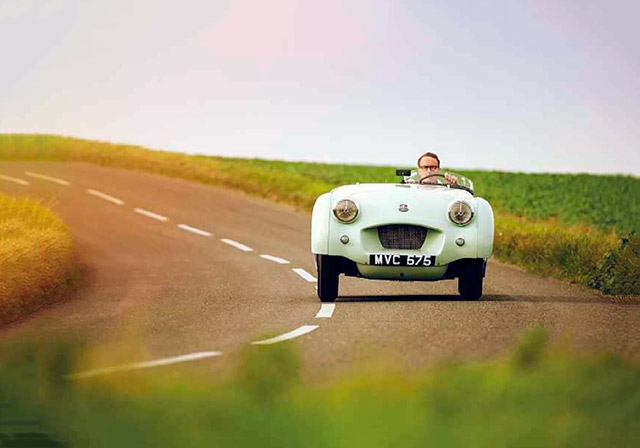
Jabbeke Triumph. Triumph’s TR2 Speed King. On the road in the very car that set a world record at Jabbeke. More than 60 years ago, this special TR2 set a speed record at Jabbeke. Now Andrew English uncovers its deeper secret. Photography Paul Harmer.
TRIUMPH OF WILL / RECORD-BREAKING TRIUMPH The famous Jabbeke TR2 restored and driven
Modern Land Speed Records tend to be marked by four-figure target speeds and toiling teams of race and aerospace engineers, but it wasn’t always so. At one time the production 2.0-litre sports-car record was held by this car, MVC 575, an achingly modest Triumph TR2. In May 1953, this geranium-green 2.0-litre machine achieved a class record of 124.899mph at the Jabbeke highway in Belgium.
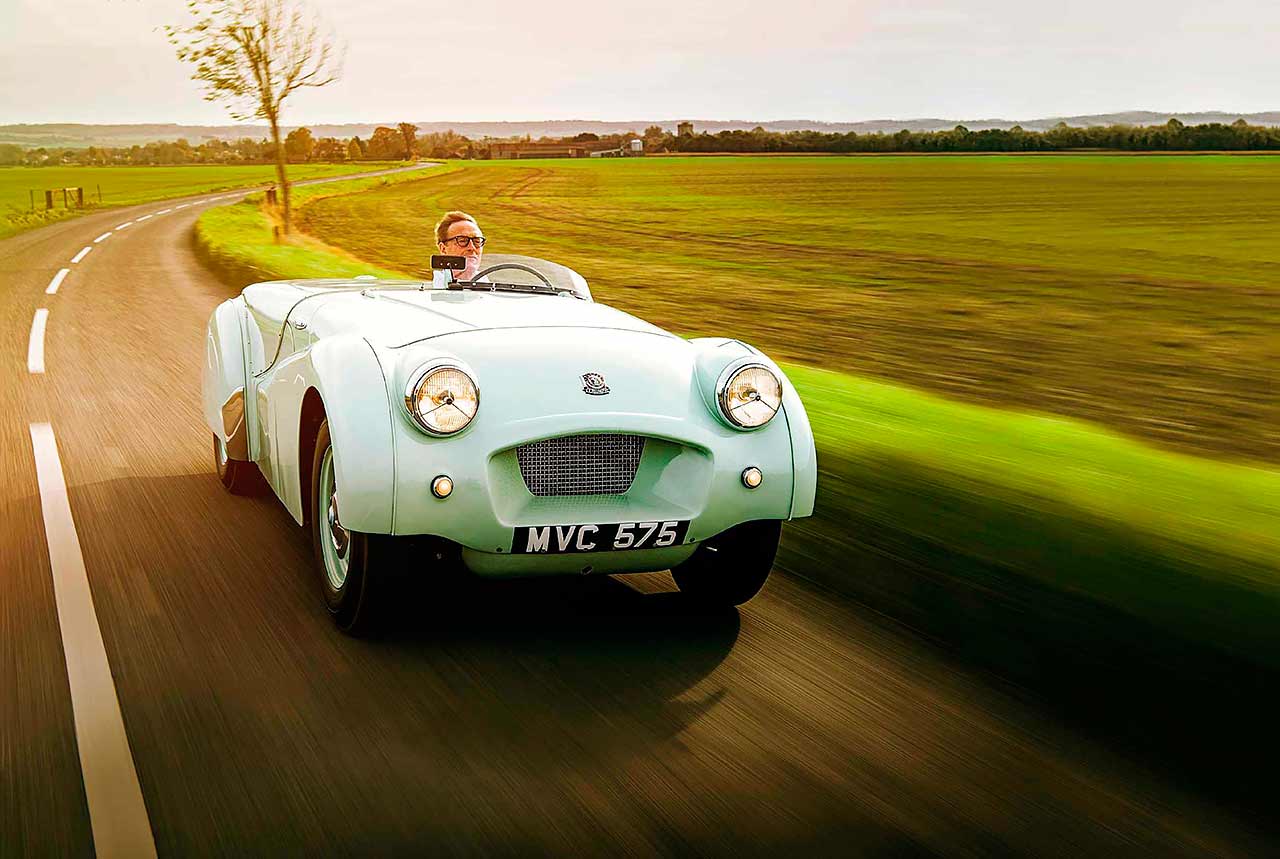
Back then, Jabbeke was a bit like the Nürburgring’s Nordschleife is for today’s hot-hatchback makers in terms of setting records. On that early motorway-graded road (with no barrier to separate record-breakers from normal traffic), in front of great-coated timing experts from the Royal Automobile Club Of Belgium, plus Brilliantined TV crews and a suited-and-booted press corps, Ken Richardson, a skilled engineer and plucky test driver, sitting on a cushion and crouched behind a tiny aero screen, coaxed out a new speed record. This was almost two months before production of the TR2 began at Canley in the West Midlands and the car’s only modifications were the optional undershield, rear- wing spats and a potentially lethal metal cockpit cover.

Lethal? It certainly feels that way sitting where Richardson sat 64 years ago in MVC 575, albeit in a proper seat, with that metal cockpit cover just brushing the back of my neck. With no seatbelts, rudimentary drum brakes and ethereal grip from its Excelsior crossply tyres, it wouldn’t take much of a drama to have your correspondent’s head bouncing free of its body down the road like an ancient leather football. In fact, this faithful recreation of the car’s long-lost original metal tonneau normally sports a non-original safety head restraint to try to prevent drivers literally losing their heads.
This decollated end could also have been Richardson’s on that record-breaking run, as he recounted in an article in Triumph Over Triumph magazine in 1998. In an unauthorised modification, the shepherd’s crook-shaped engine breather pipe had been extended downwards below the level of the undershield, where the low pressure created a siphoning effect and sucked out the sump oil. So the record-breaking run, he recalled, ‘was very nearly ruined by inept interference. The whole of the underside of the car was plastered in oil… Had the oil reached the rear wheels on my practice run, I could have lost control of the car and shot over the central reservation and into the oncoming traffic.’
Richardson blamed a senior engineer on the team, who eventually owned up, but bad feeling remained. Which is strange, because Richardson got on reasonably well with Sir John Black, the controversial chairman of Standard Triumph. With his impulsive manner and tendency towards depressive moods, by all accounts including Richardson’s, Black wasn’t always the easiest to work with.
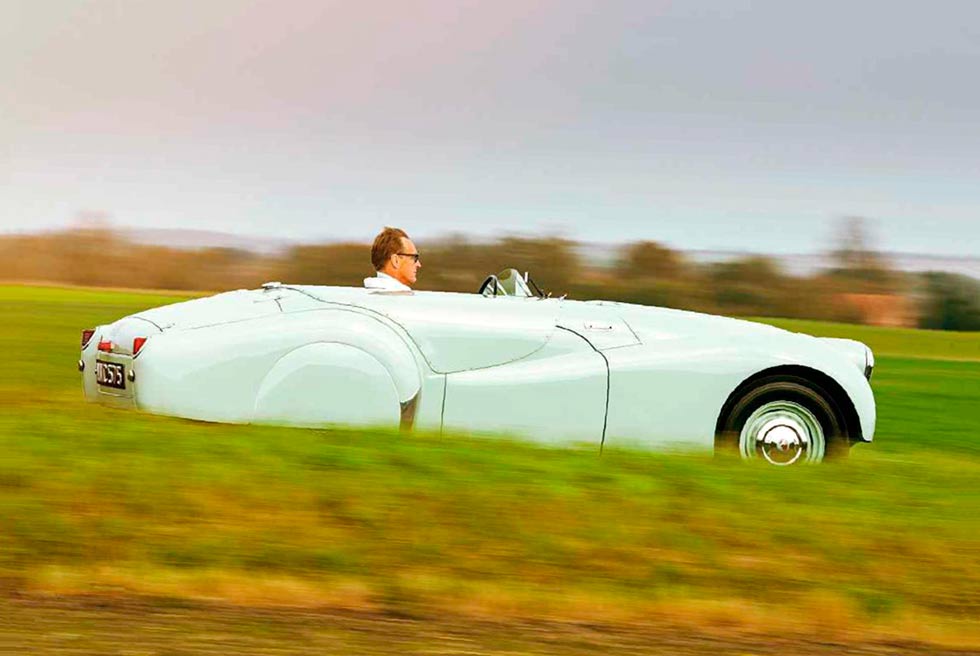
With the announcement of the new Triumph TR2 just months away in early 1953, Black had read of Sheila Van Damm achieving a speed of 120mph over a measured mile at Jabbeke in a 2.0-litre Sunbeam-Talbot Alpine. Concerned that this would affect his launch, Sir John told Richardson to organise a rival record attempt. A few days later, Black summoned Richardson to tell him the Jabbeke highway was booked for 20 May. Richardson was ‘flabbergasted’. He thought the risks of car problems or bad weather meant a two-day window was the bare minimum for such a speed record attempt. Typically Black brooked no opposition: ‘Everything’s organised now, so we’ve got to get on with it.’
Richardson wrote: ‘When Sir John says “Get on with it”, you get on with it.’
Staying at the Queen and Castle pub near Kenilworth (it’s still there), which became an unofficial base for the record-breaking run, Richardson and his small team would rise early for what became known as ‘red-eye special’ speed tests on the Bicester road near Oxford; they’d measure the road and stick in marker posts. Again disaster could have struck: ‘Those icy roads were damn dangerous,’ recalled Richardson. ‘A patch of ice caught me out on the Bicester straight, which caused a bit of a moment.’ It doesn’t bear thinking about – an engine seizure at speed, say, throwing this narrow prototype sports car into an uncontrolled slide that even a skilled and resourceful driver such as Richardson would have been able to do nothing about.
‘They had wanted to let the press drive the car after the run,’ says Glen Hewett, boss of Triumph specialist Protek of Wallingford, ‘but they couldn’t because the engine was knocking for all it was worth and there was oil all over the rear bodywork and even on the rear tyres.’ It was Hewett who tracked down MVC 575, purchased it in November 2015 and over the following 18 months painstakingly restored it.
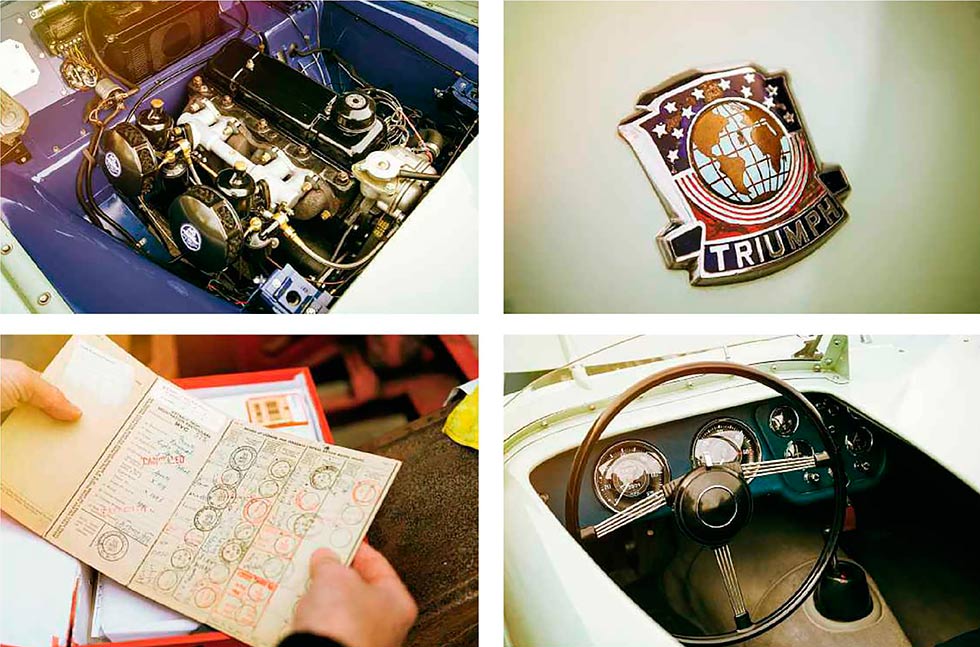
You can see how important this run was in a film commissioned by Standard Triumph (find it on YouTube by searching for ‘Triumph TR2 Jabbeke speed test’). With cut-glass commentary from Raymond Baxter, the faded film shows Sir John Black, managing director of Standard Triumph, dapper in a trilby and overcoat. ‘It was important enough to warrant a film crew,’ says Hewett, ‘but it’s doubly important as the boss is there.’
As the film shows, not just Black but the cream of the European press corps, including Basil Cardew of The Daily Express, Courtenay Edwards of The Sunday Telegraph, Peter Garnier of The Autocar, Laurie Cade of the London evening newspaper The Star, and Paul Frère. All told there were about 70 people at the eve-of-run dinner hosted by Black, all corralled by jovial PR chief Ivor Penrice in a bowler hat.
But that’s really only half the story for this extraordinary car, which has been on display pretty much full-time since it was restored last year by Hewett. Like so many prototypes, MVC was then used as a test-department hack in the factory (it was Richardson’s personal car for a while) and was sold on in October 1956 to a Mr John Hedger. Hewett has the original bill of sale for £650 from Welbeck Motors of London W1, where it was part exchanged for a Ford Popular. But through two more owners and the passage of years, it was driven into the ground until it was eventually dismantled with the intention of a restoration in 1976. And it was in that dilapidated state, spread around several lock-up garages, that Hewett tracked it down after persuading its reclusive owner to sell.
So I’m thinking about all this and the current value of this car (in excess of a quarter of a million) as I climb in, which is a struggle. Leg over like a Tory MP, then wobble upright standing on the driver’s seat and with both hands on the metal tonneau in support, you waggle your feet under the big wire-spoked Bluemels steering wheel before, with a pouf!, you disappear like a magician’s assistant into the cockpit with your head just poking out of the top. There’s time to note the contrasting blue interior (Hewett is now convinced, with some justification, that MVC 575 was originally painted blue) and the virtually standard trim.
While Richardson notes that, sitting on the floor, the runs ‘were not particularly comfortable’, TR seats of this vintage feel like over-stuffed parlour chairs with no discernable side support. The blue-trimmed dashboard is straight out of the production brochure with, in splendid isolation on the left, a push/pull overdrive switch operable on all gears except first.
A bit of choke, press the starter and the old Standard/Vanguard engine burbles into life. This cast-iron, pushrod four-pot (also used in the Ferguson tractor) always sounds breathy and MVC 575 is no exception. Hewett did little to it other than making sure it had good balance, so gently engage first with that rifle-bolt precise lever and let up the light clutch. The smalldiameter SU carbs and soft cam profiles allow it to pull hard from about 1500rpm and it feels quite brisk without you ever needing to take the revs above 4000rpm.
So many TRs have been modified for practicality, safety and reliability and that’s a shame: MCV 575 is a delight at medium speeds. It floats on those Excelsior tyres, there’s a directness and lightness to the worm-and-peg steering and a woofly exhaust note that remind of times gone by, and full throttle demands dainty feet. In that respect MVC 575 feels like a very wellmaintained original TR: even the aero screens were an option all the way up to late TR3a models, so the wind blast is familiar. It’s only the inability to hook yourself in place with your elbow over the cutaway door that tells you this is a different sort of TR. Which is all fine and good if you don’t want to go fast. When you do, however, this is a highly alternative kettle of fish.
Painfully twist your foot to get full throttle, the engine revs manfully and the gearchange slots cleanly even if the synchromesh action is best described as stately. The damping isn’t bad, and the springs are stiff enough to resist too much body roll, but the tall tyres squish through the turns, which makes the steering feel disconnected. The outside front tyre squeals in protest at any form of spirited cornering and you need to plan hard stops with an early balancing push to get the drum brakes synchronised.
This is nothing to do with Hewett’s expert preparation, it’s how they were. And all the while that metal tonneau brushes hungrily at the back of your neck…
‘Richardson was a brave man alright,’ says Bill Piggott, noted historian of all things Triumph and author of over 15 books. ‘You need to remember that he had been BRM’s test driver and drove that difficult V16 on the track and the road between the works at Bourne and the Folkingham test track.’
But Richardson’s role wasn’t just as a speed record driver; he’d been involved in the TR story from much earlier, which brings up the other remarkable part of this car’s history. Whichever way you shuffle it, MCV 575 is important. There’s little still extant from the earliest days of Triumph’s sports car series, which ultimately begat the TR range from TR2 to TR7, the GT6 and the Stag. You see just a handful of the ex-works rally cars in various stages of originality, along with some of the earliest long-door TR2 models, so this early pre-production TR2 has a huge significance – but it doesn’t stop there.
This wasn’t Black’s first attempt to challenge MG and Sunbeam in the lucrative sports-car market. Triumph’s first post-war model was the Two Litre (as driven by television detective Bergerac), which was slow, ponderous and old fashioned – one of the last new cars to have a dickey seat. A second shot was the 20 TS prototypes (later erroneously known as TR1s); most historians concede there were at least two. These Manx-tail sports cars had ghastly flexible chassis and sleepy Vanguard engines and were roundly condemned by the press on a test drive. This is where Richardson, hired from BRM, comes in. On his first test drive, he is reputed to have described it as ‘bloody awful’.
Richardson stayed with the project, which went back to the drawing board. Harry Webster improved the chassis, Lewis Dawtrey teased 90bhp out of the tough wet-liner engine, Walter Belgrove redesigned the body with a longer tail and a more practical boot, and Richardson tested and fed back. The resulting TR2 was unveiled in March 1953 at the Geneva show. And what became of those two 20 TS precursors? Things moved too fast at Standard Triumph in those days to keep accurate records and they had no money.
‘They wouldn’t have thrown anything away,’ says Hewett. ‘There simply weren’t the resources.’
So when Richardson required a pre-production TR for his record attempt, whence did he acquire the donor car? The solution became clear to Hewett as he revealed the secrets beneath the bespoke coachwork and lovely special bonnet badge of MVC 575. Riveted parts, special panels and hand fabrications, including a cover plate for the 20 TS’s strange single-sided rear trailing arm, persuaded him that MVC had been built up from one of the two 20 TS models.
Piggott, too, is convinced and says that Hewett’s car was in fact the second of the two 20 TS prototypes to be converted into a prototype TR2; the first being MWK 950, which used the uncompleted second 20 TS as a base. ‘That other prototype also exists,’ he says, ‘and we know that it was the first car to be converted as its surviving logbook shows it as registered in January 1953, two months before MVC 575 was first registered. ‘When I spoke to Ken [Richardson] he couldn’t remember which one was the Geneva show car, but it was in fact MVC 575, which was also the one he’d jollied up with an aerodynamic kit to get the record. There is a third prototype as well, ORW 666, but that right-hand-drive car wasn’t based on a 20 TS and no one is sure exactly what happened to it.’
‘And yes, it [MVC 575] is an important car. It proved that a production 2.0-litre sports car could do preposterous speeds; 125mph is a speed that not many cars can do today. And it gave credibility to Triumph’s sports-car project.’
He’s not alone in that point of view. While introducing MVC 575 at the RAC Club dinner in its honour, Tom Purves, chairman of the RAC Club, referred to it as ‘the most significant car Triumph ever built’. This former head of BMW UK and Rolls-Royce hillclimbs his Hewett-prepared TR3a and has a special place for Triumph in his heart.
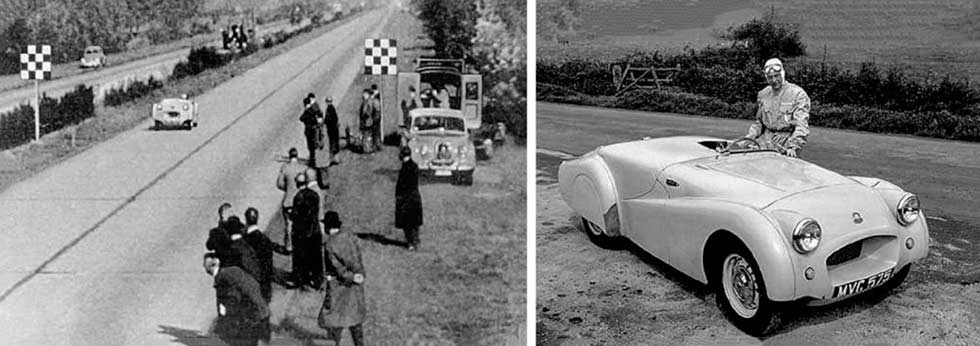
‘I like Triumph for personal reasons,’ he explains. ‘I think they did a good job of exploiting their export potential and they were very avant-garde using the Italian design house Michelotti. It’s an unappreciated part of the British Motor Industry.’
There’s an interesting footnote to the story in that Purves’ former employer BMW owns the Triumph name, which it picked up along with Rover in 1994. Indeed, there are some folk who think that BMW might one day disinter the famous Triumph marque, particularly as its own sports cars have had an occasionally patchy history – witness the current collaboration with Toyota for a Z4 replacement.
Perhaps MVC 575 might inspire them? Who knows, but hopefully whatever might come out of such an idea would be a little less like a four-wheeled guillotine than this extraordinarily important record-breaking prototype.
The TR2 is soon to be in need of a new custodian. More information is available from Glen Hewett via protek-engineering.co.uk.
TECHNICAL DATA FILE SPECIFICATIONS 1953 Triumph TR2
Engine 1991cc four-cylinder, OHV, twin SU H4 carburettors
Power 90bhp @ 4800rpm / DIN
Torque 117lb ft @ 3000rpm / DIN
Transmission Four-speed manual with overdrive, rear-wheel drive
Steering Worm and peg
Suspension Front: double wishbones, coil springs, telescopic dampers. Rear: live axle, semi-elliptic leaf springs, lever-arm dampers
Brakes All Drums
Weight 955kg
Top speed 120mph
0-60mph 11.9sec
Facing page and below ‘Guillotine-like’ tonneau cover, aeroscreens and rear-wheel spats streamlined mVC 575 to the degree that it achieved nearly 125mph at Jabbeke in 1953.
‘There’s a directness to the steering and a woofly exhaust note that remind of times gone by, and full throttle demands dainty feet’





